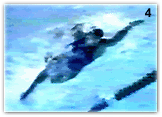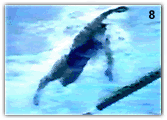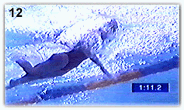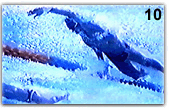


THE CRAWL STROKE KICK - NOT PROPULSIVE BUT IT AIDS PROGRESSION
I recently had a discussion with an enthusiastic promoter of swimming knowledge. At one stage, the focus turned to kicking in crawl stroke. Several commonly believed statements were proffered. This Carlile Coaches' Forum addresses those statements so their import will not be perpetuated in the Carlile Organization.
In most swimmers there are only four downbeats that constitute a kick, two for each leg each counter-balancing a vertical force component of the opposite arm. There would be no propulsive purpose for another kick during a pull, for if one was emphasized it would probably be detrimental to forward propulsion.
There are occasional movements of the legs that do not constitute full kicks but rather, are corrective movements acting like "trim tabs." They might have something to do with maintaining streamlining when complex movements need some additional minor force, such as when one arm is pulling and the other is recovering. Such movements are not in the range of actions that are practiced while doing a kicking drill. They are not counted as kicks since they serve the same purpose as hip sway or some other corrective action. They do not contribute to the generation of propulsive force developed by the arms. However, these movements are added in the count of leg "actions." It is this writer's opinion that the commonly described "six-beat kick" is actually four kicks plus two corrective leg movements.
With the appearance of very tall male swimmers, such as Ian Thorpe, a six-beat kick is possible because of the great length of time taken to complete a full stroke cycle. In Thorpe's case, the "middle" kick on each side coincides with the middle of the arm-pull phase when the arm is outside of the body's centerline. The "same-side-kick" acts to counter-balance any rotational forces created by that arm's action. Normally, a mid-pull would not be outside a swimmer's center-line, but a very tall swimmer's need to "park" a recovered arm does not allow the same extent or timing of shoulder rotation causing the mid-pull to be wider. Most top sprint swimmers exhibit six leg movements in parts of their races (e.g., Amy Van Dyken, Alex Popov, Jenny Thompson), while others perform only four (e.g., John Olsen).
The role of the kick in crawl stroke is not propulsive. A kick only serves to counter-balance the vertical forces created by an arm movement. Since both arms do produce substantial vertical force components on entry and exit those forces need to be offset so that the body "load" remains streamlined. Thus, with two arms both entering and exiting there is only a need to kick a maximum of four times during a full two-arm stroke cycle.


The two frames above are of Jenny Thompson swimming a relay leg at the 1998 Goodwill Games. For her left arm, the right leg kicks on the first re-position/entry and as extension and round-out commences at the end of the propulsive phase. Between these two kicks is another leg movement that counter-balances rotational forces created by the left arm pull.
There would be no value from a middle kick for propulsion. Added to that is the time factor. The rate of stroking would have to be slowed to allow six kicks to occur. Kick-dominated swimming was debunked in the late 1950s principally by Forbes Carlile. Stroke rates increase in competitions over those exhibited in training (Craig & Pendergast, 1979) and as the competitive distance shortens. For most swimmers, there just is not enough time to do six fully executed kicks if they all were to be of propulsive value. In the pre-1960s when gliding was fashionable, six-beats were possible but as swimmers sought to swim faster and discarded gliding for speed, two full kicks had to be eliminated. There is not the time, propulsive value, or hydrodynamic reason to perform six full kicks in crawl stroke in most swimmers.
Different kicks for different folks. Particularly among female champions, for example, Claudia Poll, Janet Evans, Brooke Bennett, and Nadezhda Chemezova, only two kicks are executed, two very large kicks. At the 1998 Goodwill Games TV commentators reported and indicated with a telestrater that Chemezova was kicking "with a six-beat kick" inferring such an action from the frothy water surrounding her kick. However, an underwater analysis of her kick at that instant showed she was doing only a two-beat action, both kicks being very large.

The frame above illustrates one extremity of the kicking action in Nadezhda Chemezova's stroke at that time. The others can all be seen in the "How Champions Do It" section of the Swimming Science Journal. Most female sprinters use a four-beat kick (see Jenny Thompson above).
How could a two-beat kick work if counter-balancing forces is a purpose of kicking? In swimmers who rate high (e.g., Janet Evans, Brooke Bennett, Claudia Poll) the mechanics usually are something like this:
It is rare that sprint or distance males demonstrate a two-beat kick. One possible reason is that males are physically much larger. Their size promotes lower stroke rates and time is available to complete the six beats (four kicks plus two corrective actions). It is interesting to note that in commentaries on the record swims of Kieren Perkins it is often said that he varied between a two and six-beat kick in this races. However, in his record swims between 1992 and 1994 rarely did his kick exhibit a sole two-beat action. Actually, his left arm pull was always accompanied by two kicks while his right arm varied between one and two kicks. Many observers mistakenly described increases in Perkins' kicking vigor for increases in frequency. Perkins kicking at the 1440 m mark of his 1500 m Gold medal swim for his right arm pull are illustrated below.


CRAWL STROKE KICKS DO NOT PROPEL
The shank and foot of the human leg have the characteristics of cylinders, not airfoils. The only propulsive forces they can generate that would be propulsive would be drag forces.
It is frequently proposed that flexible ankles position the lower limb to facilitate kicking backward, which would produce a forward thrust. However, research has shown that not to be true (Mookerjee, Bibi, Kenney, & Cohen, 1995). No champion swimmer exhibits such a position when swimming (see all the examples in "How Champions Do It"). If the foot is placed in the often illustrated and demonstrated posture of kicking backward, it is out of the water where no propulsive forces are possible. The picture below illustrates Claudia Poll with the lower half of her shank and foot above the water's surface.

There is a further problem with the concept that crawl stroke kicking can be propulsive. To create any force that might be propulsive, no matter how weak, it has to be completed before the shank and foot are horizontal. When speed swimming that has to be accomplished close to the surface. The zone where the action takes place is not conducive to force development. It is an area of severe drag turbulence created by the leading body of the swimmer. It is an area of wave turbulence as well. A kick would only be successful if it was in relatively undisturbed water. When using a kick board, the slower velocity and the different posture sets up a water surface zone that is less disturbed than that which occurs with full speed swimming. That is another reason why some progression is possible doing kicking drills. Even if a swimmer was able to manipulate a leg and foot into a posture where some force could be productively applied, the inhospitable hydrodynamic environment thwarts that application.
IF CRAWL STROKE KICKS DO NOT PROPEL THEN WHAT DO THEY DO?
If crawl stroke kicks do not propel then what do they do? There are two ways to increase swimming speed: increase propulsion and decrease resistance. Since crawl stroke kicks serve to counter-balance vertical force components inherent in crawl stroke arm actions, they facilitate keeping the non-propulsive "head-body-thigh" transport loads streamlined. If a swimmer did not kick, then the counter-balancing action would be primarily hip elevation or sway and secondary shoulder elevation or sway. The two pictures below illustrate Alexandre Popov kicking early and late in one arm pull and his streamlined body position.


A kicking movement also allows a stronger stroke re-positioning ("set-up") that translates eventually into a stronger pull. Costill, King, Holdren, and Hargreaves (1983) found that arms-alone swimming produced only 51% of crawl stroke power. Strong kickers were found to gain substantially more than weak or two-beat kickers when kicking was integrated into the stroke. As well, kicking facilitated a longer length of effective stroking.
THE PRINCIPAL ACTION OF CRAWL STROKE KICKING IS TO MAINTAIN STREAMLINE AND TO FACILITATE BETTER STROKING MECHANICS AND POWER
This edict requires a caveat. If a crawl stroke swimmer rotated the hips enough then the foot could be repositioned with notable flexion of the knee to produce a thrusting movement backward (forward propulsion for a brief period). However, the extra time to position the foot and execute that extra part of the movement would require the arm stroke rate to be lowered, something that usually does not feel right to an experienced swimmer. Even if that extra part of the kick were effected it would not generate forces of sufficient magnitude to propel the swimmer fast. This is because it would occur at the start of the movement where some movement distance is sacrificed to facilitate acceleration and its arc of movement diminishes the component of effective force as it is executed.
WHAT VALUE ARE KICKING DRILLS?
What value then are kicking drills?
Kicking drills, particularly on boards, practice a neuromuscular skill that has no relationship to that performed in a full crawl stroking action. On a board, slow propulsion is produced by altering the posture of the body, particularly the thorax and lumbar regions, so that frequent short weak forces can be developed backward. In addition, a board reduces the scope of kicking actions, normally limiting them to being performed in a vertical plane. That restriction is counter-productive for actual swimming when the alignment of kicks should follow correctly executed hip rotation. In good crawl stroking, kicks should only be vertical for a moment, spending most of the time cycling from side to side.
Better kicking drills might occur if boards were eliminated and the swimmer mimicked side-to-side rotations of the shoulders and hips. However, even then the neuromuscular actions practiced would not be specific to actual swimming. On a kicking board or in a no-board drill a kick is proactively propulsive but in a full swimming stroke it is reactive to arm stroking. What is done with the arms causes a kicking movement. That form of movement cannot be replicated in a kicking-alone activity.
The three values indicated above might be the most important outcomes of kicking practices and drills. They certainly do not suggest any carry-over to competitive swimming crawl strokes.
CLOSURE
The common attributions of kicking in crawl stroke technique are erroneous. Kicking facilitates speed swimming by facilitating streamline, supporting more powerful and effective arm strokes, and counter-balancing vertical force components involved in arm actions. Kicking does not contribute to propulsion in a direct way.
References
Return to Table of Contents for Carlile Coaches' Forum.
